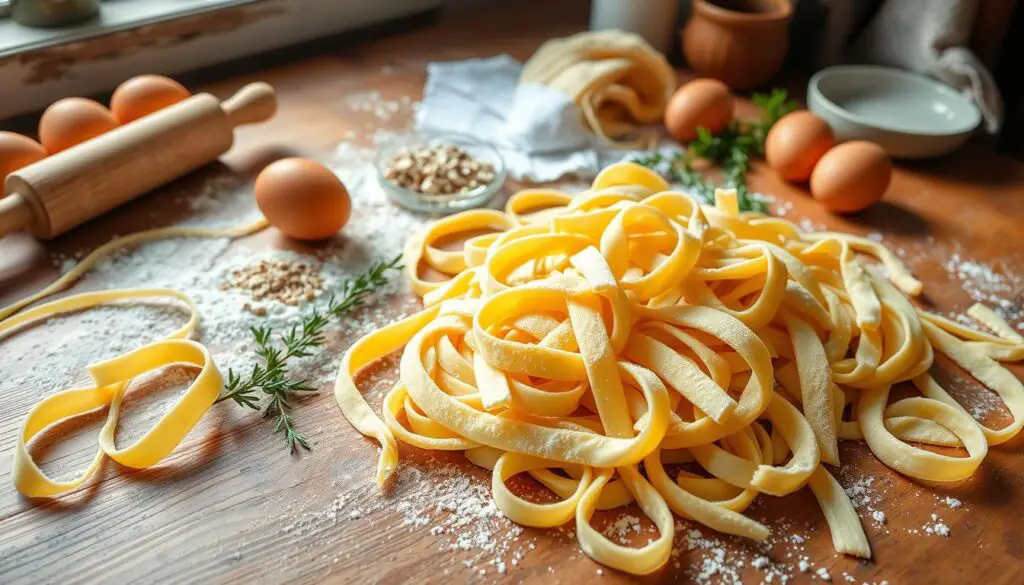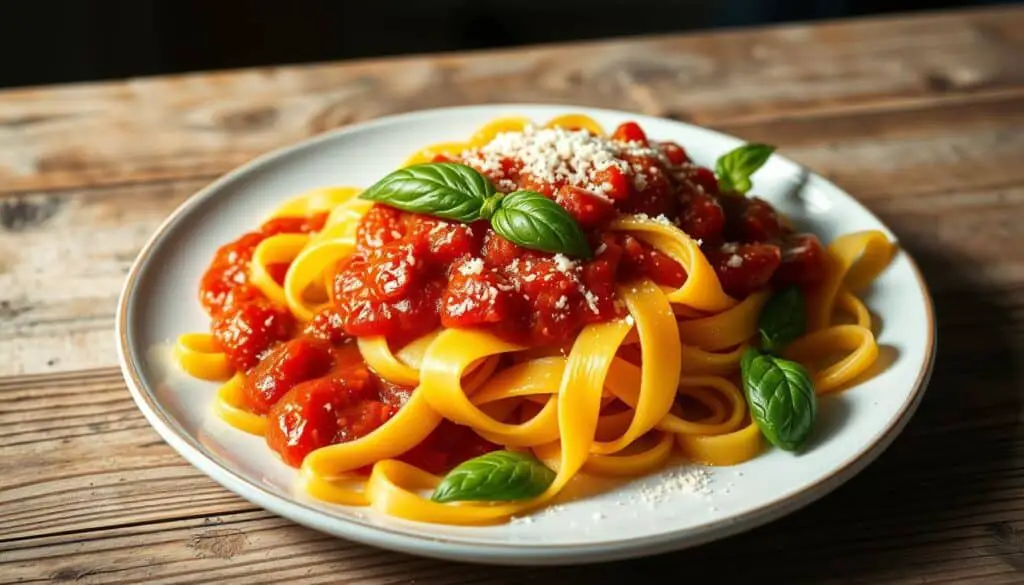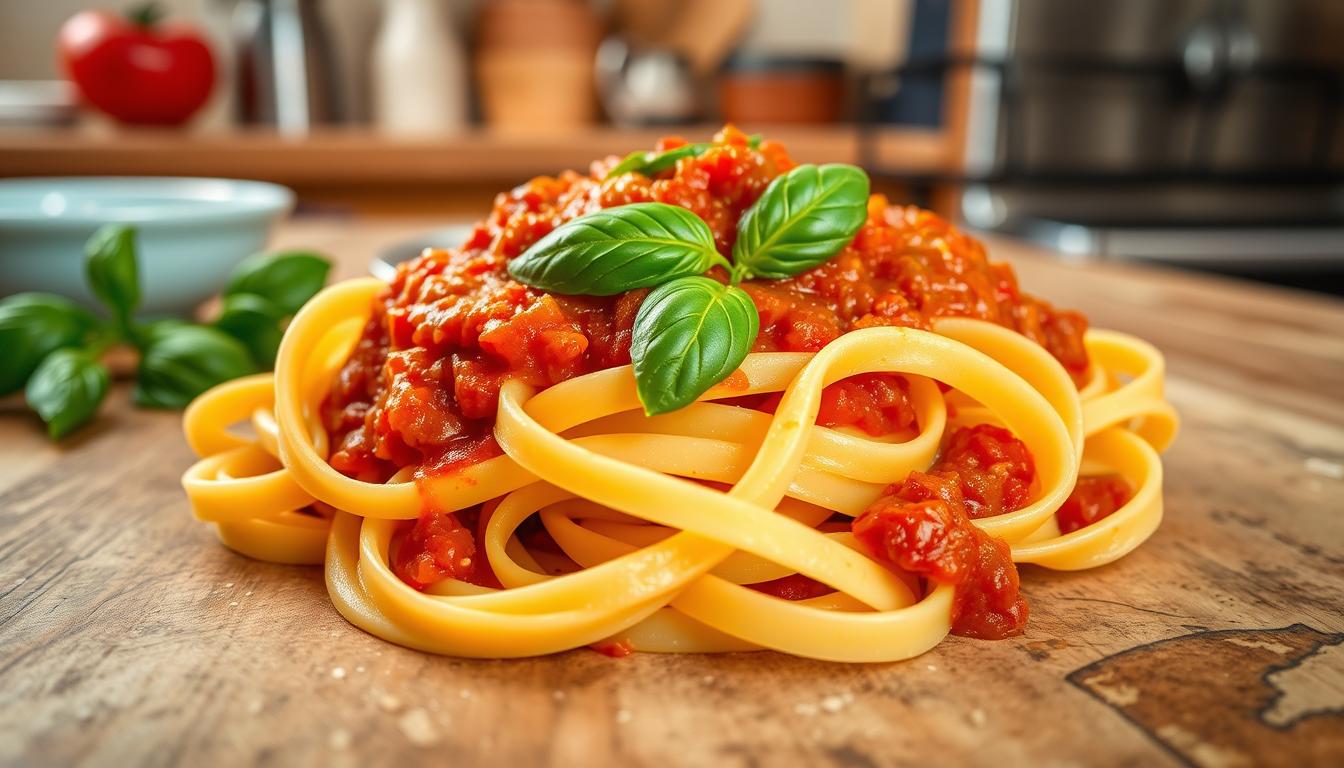As I stood in the bustling kitchen, the smell of tomatoes and garlic filled the air. It reminded me of my childhood. In my Italian-American home, pappardelle pasta was always on the table. Its wide noodles soaked up the rich sauces my grandmother made.
Now, I’m excited to share pappardelle with you. It’s a pasta from the Emilia-Romagna region in Italy. Made from flour, eggs, and salt, it has a chewy texture. It’s perfect with Bolognese or creamy Alfredo sauces.
Key Takeaways
- Pappardelle is a wide, flat pasta from the Emilia-Romagna region of Italy.
- It’s made from simple ingredients like flour, eggs, and a pinch of salt, giving it a delicious, chewy texture.
- Pappardelle pairs perfectly with hearty sauces, such as Bolognese or Alfredo, making it a versatile pasta choice.
- Explore the rich history and authentic flavors of this beloved Italian pasta.
- Discover the joy of incorporating pappardelle into your own culinary creations.
Homemade Pappardelle: A Taste of Italy
Making pappardelle pasta at home is easy and rewarding. This wide, flat pasta comes from Italy’s Emilia-Romagna region. With just flour, eggs, and olive oil, you can make fresh pappardelle at home.
Simple Ingredients, Delicious Results
The recipe for homemade pappardelle is simple. You need unbleached all-purpose flour and semolina flour for the right texture. Adding egg yolks makes the dough rich and smooth. A bit of salt and olive oil finish the ingredients.
Easy to Make at Home
Turning the dough into Fettuccine noodles is fun. Let the dough rest, then roll it out and cut it into wide ribbons. This homemade pasta tastes great and is a fun cooking experience.

“Making homemade pappardelle is a simple pleasure that transports you to the heart of Italian cuisine.”
What is Pappardelle?
Pappardelle is a wide, flat pasta from Italy’s Emilia-Romagna region. The name “pappardelle” means “to gobble up” in Italian. It’s made from durum wheat flour and has a broad, ribbon-like shape. This shape is perfect for soaking up hearty sauces.
Wide, Flat Ribbons of Pasta
Pappardelle is known for its wide and flat shape. This sets it apart from other pasta types. The wide strips of pappardelle help sauces stick well, making for a flavorful meal. It’s especially good with rich, meat-based sauces like Bolognese.
Origins in Emilia-Romagna Region
Pappardelle is a traditional pasta from Italy’s Emilia-Romagna region. It’s been enjoyed for centuries, often with slow-cooked, tomato-based sauces. These sauces often include beef, pork, or lamb. Pappardelle’s history goes back to the 14th century, when it was enjoyed during special occasions in Tuscany.

“Pappardelle is known for its wide and flat shape, making it ideal for pairing with rich sauces.”
| Pasta Characteristic | Pappardelle | Egg Noodles |
|---|---|---|
| Shape | Wide, flat ribbons | Soft, tender |
| Ingredients | Durum wheat flour and water | Flour, water, and eggs |
| Cooking Time | 8-10 minutes | 6-8 minutes |
| Typical Pairings | Hearty meat-based sauces | Soups, stir-fries, and noodle dishes |
In summary, pappardelle is a unique, wide flat pasta from Italy’s Emilia-Romagna region. Its shape and texture are perfect for rich, flavorful sauces, especially those with slow-cooked meats.
The Perfect Pappardelle Pasta Dish
Pappardelle with Bolognese Sauce
Enjoying pappardelle pasta with Bolognese sauce is a classic treat. The wide noodles soak up the meaty sauce perfectly. Each bite is full of flavor, making it a comforting Italian pasta dish.
To make this pappardelle with Bolognese dish, you’ll need a few ingredients:
- ¾ lb of dried pappardelle pasta
- ½ lb of ground beef or Italian sausage
- 1 large onion, finely chopped
- 3 garlic cloves, minced
- 1 can (28 oz) of crushed tomatoes
- 2 tbsp of tomato paste
- 1 cup of beef or chicken broth
- 1 bay leaf
- 1 tsp of dried oregano
- Salt and pepper to taste
- Freshly grated Parmesan cheese for serving
Start by browning the ground meat in a skillet. Then, add the onions and garlic. Stir in the tomatoes, tomato paste, broth, bay leaf, and oregano. Let it simmer for 30-45 minutes.
While the sauce cooks, prepare the pappardelle pasta as directed. Toss the hot pasta with the Bolognese sauce. Serve it with Parmesan cheese. This pappardelle pasta dish is a classic Italian pasta with meat sauce that everyone will love.
“Pappardelle with Bolognese sauce is a match made in heaven. The wide, flat noodles are the perfect vessel for the rich, meaty sauce, creating a truly satisfying and comforting Italian classic.”
Pappardelle: The Ultimate Comfort Food
Pappardelle is a top pick for satisfying pasta dishes. Its wide, flat shape is a joy to look at and eat. It’s great at soaking up rich sauces, making every bite a treat.
The wide noodles of pappardelle offer a big, satisfying bite. They pair well with many sauces, like Bolognese, Alfredo, or marinara. This makes for a meal that warms you up inside.
Making pappardelle at home is easy and fun. You need just a few ingredients to create a batch. It cooks quickly and is simple to prepare. This makes it perfect for cozy, comforting meals.
“Pappardelle is the ultimate comfort food, with its satisfying texture and ability to soak up rich, flavorful sauces.”
For a meal that feeds your soul and pleases your taste buds, try pappardelle. It’s the perfect mix of pappardelle comfort food, homemade pasta comfort food, and hearty italian pasta. It’s a warm hug in a bowl.
Cooking Pappardelle Like a Pro
Preparing pappardelle pasta is easy and fast, making it great for weeknights. It cooks in 5-6 minutes in boiling water. This quick cooking lets you serve dinner fast.
The wide, flat shape of Fettuccine pairs well with many sauces. It’s perfect with Bolognese or Alfredo. Every bite is full of flavor because it holds onto the sauce well.
Quick Cooking Time
Pappardelle cooks faster than most pasta, in 6-8 minutes. Boiling it in salted water makes it ready quickly. This is great for busy nights when you need a fast meal.
Pairing with Sauces
The flat shape of pappardelle is great for sauces. It holds onto the sauce, making each bite flavorful. It works well with Bolognese, Alfredo, or pesto. It’s a great way to show off your cooking skills.
| Pasta Shape | Cooking Time (minutes) |
|---|---|
| Spaghetti + Linguine | 8-10 |
| Bucatini | 10-12 |
| Angel Hair + Capellini | 4-6 |
| Penne + Ziti | 6-8 |
| Farfalle (Bowties) + Shells | 8-10 |
| Rigatoni | 11-13 |
| Orecchiette | 12-15 |
| Fusilli + Rotini Noodles | 8-10 |
| Pappardelle + Fettuccine | 6-8 |
Pappardelle cooks fast, making it versatile for many dishes. It’s perfect for quick meals or impressing guests. It’s a great choice for any pasta dish.
Pappardelle Nutrition and Health Benefits
Pappardelle, the wide and flat pasta ribbons, is a nutritious choice for your diet. It’s made from simple ingredients like flour, eggs, and salt. This homemade pasta is lower in calories and fat than many store-bought options.
Making pappardelle at home with quality ingredients means it’s packed with nutrients. It’s also lower in preservatives than store-bought pasta. Pair it with healthy sauces and toppings for a balanced meal.
Let’s explore the nutritional profile of Fettuccine:
- Calories: A 2-ounce serving of dried white pasta, like pappardelle, contains about 200 calories.
- Protein: Pappardelle provides around 7 grams of protein per 2-ounce serving.
- Fiber: Homemade pappardelle contains approximately 2 grams of fiber per serving, making it a relatively high-fiber pasta option.
Whole-wheat pappardelle offers more nutritional benefits than traditional white pasta. It has double the fiber and more protein. Bean-based pappardelle is even higher in protein and fiber.
Pasta is affordable, costing about $1 to $2 per box. That’s under $0.20 per serving. Plus, pappardelle dishes can be ready in 30 minutes or less, perfect for busy nights.
So, if you’re looking for a nutritious pasta option or a comforting meal, pappardelle is a great choice. It’s part of a balanced, healthy diet.
Storing and Reheating Pappardelle
Homemade pappardelle pasta is a tasty and flexible meal choice. But, how do you store and reheat it best? These tips will help keep your pasta fresh and tasty, whether it’s leftover or made ahead.
Refrigerator and Freezer Tips
You can store fresh pappardelle in the fridge for 3-4 days. Use an airtight container to keep it moist. For longer storage, freeze it for up to 3 months. When freezing, toss the noodles with 1 tablespoon of oil per 8 ounces of pasta to prevent sticking.
To reheat fridge pappardelle, boil it for 1-2 minutes. You can also microwave it for 15-25 seconds. When reheating, keep the pasta and sauce separate for the best taste and texture.
Frozen pappardelle can be reheated in boiling water without thawing. Just add 1-2 minutes to cooking time. You can also reheat it in the oven or microwave, adding water or sauce to prevent drying.
By following these easy tips, you can enjoy homemade pappardelle anytime. Whether it’s leftovers or a batch made ahead, your pasta will stay fresh and delicious.
Variations and Creativity with Pappardelle
Pappardelle is known for its classic dishes, but it’s also a canvas for creativity. Its wide, flat shape is perfect for pappardelle variations and creative pappardelle dishes. You can try many different sauces and mix-ins.
Imagine pairing pappardelle with a creamy mushroom ragù or a zesty lemon and herb sauce. For a fresh twist, toss it with vibrant pesto and top it with roasted veggies. The options for different pappardelle recipes are endless.
Be bold with your Fettuccine toppings and mix-ins. Add crispy pancetta or sautéed shrimp for protein. Fresh herbs, grated cheese, or toasted nuts can add a flavorful finish.
| Pappardelle Variation | Ingredients | Prep Time |
|---|---|---|
| Pappardelle with Roasted Vegetable Ragù | Pappardelle, roasted bell peppers, zucchini, onions, garlic, tomato sauce, parmesan | 35 minutes |
| Lemon and Herb Pappardelle | Pappardelle, lemon zest, fresh parsley, basil, olive oil, garlic, salt, pepper | 20 minutes |
| Pappardelle with Pesto and Grilled Chicken | Pappardelle, basil pesto, grilled chicken, cherry tomatoes, pine nuts | 25 minutes |
Pappardelle is perfect for any dish, from hearty to light. Its wide shape lets you create creative pappardelle dishes that match your mood. Let your imagination soar with this beloved pasta.
Conclusion
Pappardelle is a delightful pasta that should be in every home cook’s collection. Its wide, flat shape and chewy texture make it perfect for rich sauces. Making homemade pappardelle is easy and rewarding, bringing authentic Italian dining to your kitchen.
Enjoy Fettuccine with classic Bolognese, creamy Alfredo, or unique seasonal sauces. It’s a versatile pasta that suits many tastes and dietary needs. You can even use gluten-free fettuccine or zucchini ribbons as substitutes.
The history of Tuscan pasta-making adds to pappardelle’s charm. From the Etruscan era to the Renaissance, it’s a tradition worth celebrating. Try making your own pappardelle and enjoy the flavors and techniques passed down through generations. For a refreshing twist, consider incorporating tropical fruits into your dishes; check out this guide on tropical fruits for some inspiration!
FAQ
What is pappardelle pasta?
Pappardelle is a traditional Italian pasta, originating from the Emilia-Romagna region. Known for its wide, flat shape, typically measuring about 1 inch in width, pappardelle is made from a simple mixture of flour, eggs, and salt. This combination creates a chewy texture that is particularly well-suited for rich, hearty sauces like Bolognese or ragù. Its robust nature allows it to hold up against thick, meaty sauces, making it a favorite among pasta lovers.
How is homemade pappardelle made?
Making homemade pappardelle is a rewarding culinary experience. You start with all-purpose flour, fresh eggs, and a drizzle of olive oil. After mixing the ingredients, you knead the dough until smooth and elastic. Then, you roll it out thinly using a pasta machine or a rolling pin. Finally, cut the rolled dough into wide ribbons using a sharp knife or a pasta cutter. This process not only allows you to enjoy fresh pasta but also to customize the thickness to your liking.
What are the origins of fettuccine?
While pappardelle and fettuccine share similarities, they have distinct origins and uses. Pappardelle is particularly associated with Tuscany, while fettuccine is more common in Roman cuisine. The name “pappardelle” derives from the Italian verb “pappare,” which means “to gobble up,” reflecting its delightful taste and texture that encourage generous servings. It’s often paired with flavorful sauces that complement its wide shape.
How is it best enjoyed?
This pasta shines when served with classic dishes like Bolognese sauce, where the wide noodles can soak up the thick, meaty sauce, delivering a burst of flavor in every bite. Additionally, pappardelle can be served with lighter sauces, such as a fresh tomato and basil sauce or a creamy Alfredo, allowing for a range of culinary possibilities.
Why is it considered comfort food?
Pappardelle is considered comfort food due to its satisfying texture and ability to pair with a variety of sauces. The process of making and enjoying this pasta can evoke feelings of warmth and nostalgia, especially when shared with family and friends. Its hearty nature makes it perfect for cozy meals, whether it’s a family dinner or a special occasion.
How long does it take to cook fettuccine?
Cooking fresh pappardelle is quick and straightforward. It usually takes about 5-6 minutes in boiling water to reach the perfect al dente texture. This quick cooking time makes it an excellent choice for busy weeknight dinners, allowing you to whip up a delicious meal in no time.
Is pappardelle a healthy pasta option?
Pappardelle can be a healthy choice when made with whole ingredients. The traditional recipe uses just flour and eggs, resulting in a pasta that is lower in calories and fat compared to many store-bought varieties. You can also explore whole wheat or alternative flours for added nutrition.
How can homemade fettuccine be stored and reheated?
Freshly made pappardelle can be stored in an airtight container in the refrigerator for 3-4 days. For longer storage, you can freeze it for up to 3 months. When you’re ready to enjoy it again, simply boil it for 1-2 minutes or reheat in the microwave for 15-25 seconds, ensuring it retains its delightful texture.
What are some creative ways to enjoy it?
This versatile pasta lends itself to a variety of delicious preparations. Experiment with a creamy mushroom ragù, zesty lemon and herb sauce, or vibrant pesto made from fresh basil and garlic. You can also pair it with seasonal vegetables, seafood, or even use it in a hearty soup for a comforting twist.
To learn more about the field of cooking, please visit us on our Facebook page
